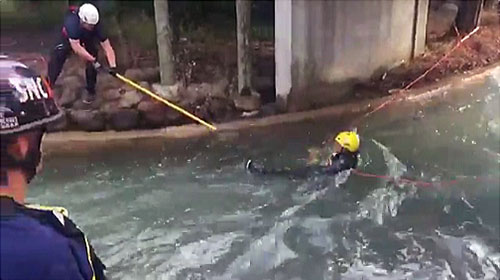Knock on wood, but Santa Clara has weathered the drought-breaking winter storms with only minor electrical power outages of short durations–seven of 18 between Jan. 1 and Feb. 20 were tree related–and no flooding.
“A little bit of luck and a lot of preparation really help. City preparedness efforts help keep our losses to a minimum,” said Santa Clara Fire Department Chief William Kelly. “We’re fortunate in Santa Clara that our creeks were able to handle in-channel water flow, though they flowed at near capacity on some occasions.”
Three seasonal creeks run through Santa Clara, which are part of the Guadalupe River and West Valley watersheds: San Tomas Aquino Creek, Saratoga Creek and Calabazas Creek. All are fed by other creeks and catch rain and runoff water via City storm drains.
The three creeks, originating in the Santa Cruz Mountains, flow north and empty into San Francisco Bay. The middle portion of San Tomas Aquino Creek, which flows in total for 16.5 miles, runs under or alongside San Tomas Expressway. Calabazas Creek is 13.3 miles long and feeds into Guadalupe Slough before flowing into the bay. Saratoga Creek flows about 14 miles before feeding into San Tomas Aquino Creek.
Proactively, Santa Clara Fire Department (SCFD) emergency responders survey the creeks and clear them of tree limbs and debris that would impede water flow. They train annually for swift water rescue, simulating actual rescues–usually in local creeks. And while the SCFD stands ready to assist other communities in an emergency, it has not needed to do so this year.
City Emergency Services Coordinator Lisa Schoenthal at SCFD works in partnership with the County Office of Emergency Services to coordinate information and resources. During the severe storms, she took part sometimes three or four times a day in conference calls the County office facilitated.
Within Santa Clara, Schoenthal coordinates emergency response with all City departments, including Silicon Valley Power.
“Technically, I’m always on 24-hour standby. We’re always ready to provide services to support our community if needed–any time, day or night,” said Schoenthal. “I have been especially vigilant during this time.”
In an emergency or high security situation such as Super Bowl 50 at Levi’s Stadium in Feb. 2016, the City emergency response team operates out of an undisclosed location as part of its security plan. The City contacts residents using the Alert Santa Clara County emergency notification system (www.sccgov.org/sites/alertscc), social media and, if residents are signed up, Nixle (www.nixle.com).
The Santa Clara County Water District (www.valleywater.org), which manages about 275 miles of county creeks, 10 reservoirs and three water treatment plants, is a source of timely information. It also maintains reports on historic floods dating from 1955. To see if your property is in a Special Flood Hazard Area, called a “100-year floodplain,” check the Central Park Library or call the City Planning Department, (408) 615-2450.
“We’ve had many years of drought, but it’s important to remain vigilant and prepared to respond to water emergencies. Also, it reminds us how important it is to be prepared for any large-scale emergency and have supplies on hand,” said Chief Kelly.
“The Community Emergency Response Team Citizens’ Academy (CERT) program is designed to help residents to be self-sufficient after a major disaster, when the scope of incidents can be overwhelming, and the need for a well-trained civilian work force can be invaluable,” said Kelly.
Visit www.santaclaraca.gov/CERT for the 2017 first responder training schedule and other emergency information. A free, three-hour disaster preparedness course is offered four times a year. The next one is scheduled June 6, 6-9 p.m. at the Fire Training Center.
“There is no boredom or panic in emergency management. We plan, train, drill and exercise on an on-going basis so we can remain calm when we need to respond,” said Schoenthal, who had just spent the day at a County earthquake exercise.












0 comments